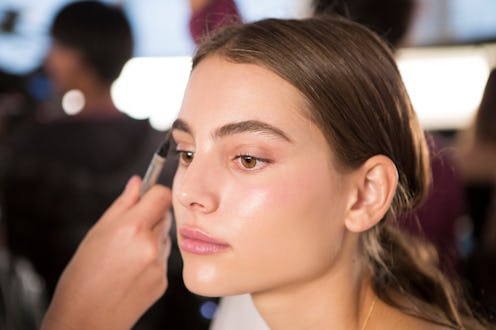Unlike normal blemishes, cystic acne are those bumps that embed themselves deep under the skin. They are large, tend to swell, and cause pain. Most of the time, they do not come to a head and trying to pick and pop them only causes further damage like scarring, inflammation, and infection. If this is your struggle, you're not alone, because cystic acne in your thirties, and late-twenties, is a thing. “Fifty-four percent of women older than the age of 25 have some form of facial acne,” the International Dermal Institute reported. Sometimes, it can't be helped.
What Causes It?
“Cystic acne occurs due to massive inflammation of the backed up oil gland structure due to factors related mainly to the immune system’s response to the blocked oil gland structure. Those with oily skin and delicate oil gland ducts are particularly prone to cystic acne," says Dr. Craig Kraffert, board certified dermatologist and president of president of Amarte Skin Care. "The inflammatory response to acne lesions is a key driver of cystic lesions. The exact triggers of this intense inflammation are variable and not entirely understood."
Even though the exact causes cannot be singled out, many think that hormones play a key role. “Usually, cystic acne is due to hormonal changes which affect oil glands deep in the skin, causing them to be overactive, and over produce oil, then leading to cyst formation,” Dr. Tony Nakhla, board certified dermatologist and founder of EIGHTH DAY explains.
“Cystic acne is commonly increased in your thirties as this is when the skin is most susceptible to hormonal changes. The hormonal shifts affect the oil glands and sebaceous glands in the skin,” Dr. Purvisha Patel, board certified dermatologist and founder of Visha Skincare adds.
According to Dr. Kraffert, the causes of cystic acne go beyond oil. “Some dermatologists believe that this hormonal change can be triggered by stressful work and personal environments, as this problem seems to be somewhat more common in patients with more driven personality types,” he says.
What To Avoid
Yes, it's hard to leave these painful bumps alone, but it's important to avoid touching the cyst. “Avoid picking, prodding, and probing into the skin which will only lead to more scarring and hyper-pigmentation,” Dr. Nakhla emphasizes.
Most want to use at home remedies to help clear skin, but that might cause the flare up to worsen. Dr. Kraffert suggests avoiding aggressive at-home physical scrubs, such as apricot seed cleanser, because they may cause more acne flares.
“Products that are occlusive, such as petrolatum-based creams, or edible products such as coconut oil clog pores — they feed bacteria and fungus — can make breakouts worse,” Dr. Patel warns.
Treatments
Clearing up cystic acne isn't an overnight fix, and it takes consistency and dedication to find a solution. If you're searching for products to help, “topical creams with tretinoin, retinol, or acids help exfoliate the skin to prevent the cysts from forming,” Dr. Patel says. “Tea tree oil, benzoyl peroxide, and sulfur topicals also help to decrease bacterial and fungal colonization of the skin.”
Since these cysts are extremely painful, finding relief could mean a visit to your dermatologist. “Injections with cortisone into the cysts causes immediate relief within an hour and can be performed by a board-certified dermatologist. Also, simple ice packs will alleviate pain and reduce inflammation,” Dr. Nakhla suggests.
Decreasing the inflammation ultimately helps decrease the pain factor, too. So as tough as it might be, don't pick or squeeze the area, it will get more inflamed and hurt even more, Dr. Patel notes.
What you eat also plays a role in treating this particular type of acne. “Diets rich in fish seem to protect your skin, while milk consumption, especially skim milk, is correlated with up to a two-fold increase in acne risk,” Kraffert explains.
Ahead, the most powerful products to help banish these painful bumps.
We only include products that have been independently selected by The Zoe Report's editorial team. However, we may receive a portion of sales if you purchase a product through a link in this article.
